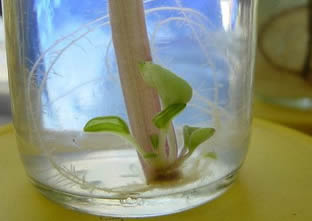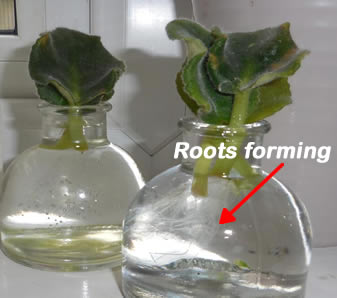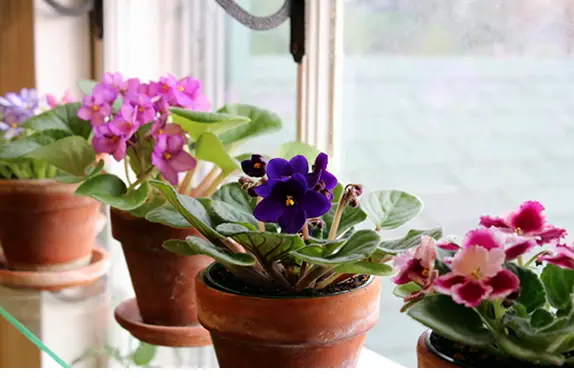In this article I cover everything you need to know about cultivating and growing african violets in water. I outline if its possible for you to propagate african violet in a water growing medium and at what point a propagated african violet should be removed from the water. I also highlight alternatives to propagating african violet in water.
Table of Contents
The only way african violets can be grown in water
If you are a regular visitor to this website then you will know that I have covered different aspects of growing african violets many times already.
I have previously outlined the watering requirements of african violet. In this article though I want to address the issue of keeping african violets in water for prolonged periods and the effects it can have on the plant.
African violets grow best in moist soil as they are thirsty plants.

But I also highlighted in the aforementioned article african violets will wither and die in soil that is drenched or soaked with water.
As counterintuitive as it may seem, too much water can actually cause dehydration in an african violet plant.
>How does this happen?
When african violet roots sit in water they develop a problem called root rot.
Root rot restricts the roots ability to actually absorb the water and distribute it to the rest of the plant.
Adult african violets cannot grow in water.
African violets that are allowed to sit in water will develop root rot and will die.
It is possible to root african violet leaf cuttings in water however, but they cannot be left in the water to grow long-term.
A quick note: although african violets prefer to be watered from the bottom it is never a good idea to leave an african violet sitting in water for any longer than 45 minutes.
Unfortunately, I find that there is often confusion between growing african violets in water and propagating african violets in water. They are not the same thing.
An adult african violet, or a newly african violet cutting, should never be allowed to sit in water for prolonged periods of time.
An adult plant and a rooted cutting should be grown in the correct type of soil which should always be kept moist but never waterlogged or drenched.
See our african violet soil guide for more information on soil type and nutrient levels.
As african violets should not be left sitting in water, you may become confused when you come across information about growing african violets in water.
Any accurate information about growing african violets in water refers to the propagation and cultivation of a new african violet plant. This usually refers to rooting a leaf cutting taken from a parent plant, and not actually growing the plant in water.
African violets can only grow in waster during the rooting stage.
In truth, propagating a new plant in water is not actually the same thing as trying to grow an african violet in water.
Propagating african violet in water is merely using the water as a means of promoting new root growth in a leaf cutting.
This is done by leaving the leaf in the water for only a short period of time until the cutting develops roots. Remove it when it shows signs of new leaf growth – the tiny new leaf that grows near the stem of the cutting is actually the new plant.
To better understand how this process works and how it can be one way of propagation for african violets I will cover that subject matter now.
How to root an african violet in water
We now know that a fully formed african violet should not be grown in water. But, can you root a new cutting in water?
You can root an african violet in water. However, african violet cuttings root best in soil.
It is common for problems to arise with african violet cuttings, that have rooted in water, when they are transferred to soil.
Any african violet leaf cutting that still has its stem intact can be rooted in water.
Ideally you should take a leaf cutting so that about 1 to 1 and half inches of the leaf stalk (called the petiole) remains.
A few points to consider:
- Remember to change the water.
- Do not allow the foliage/leaf to become submerged in the water.
- Ensure the cutting has good indirect light.
- After healthy roots grow and just after you see signs of new foliage growth remove the cutting from the water.
- Be prepared for problems when water-rooted cuttings are transferred to soil.
Let’s quickly take a look at the above 5 mentioned points.

It is important to change the water that your african violet leaf is rooting in on a regular basis.
Some gardeners will place small pieces of charcoal at the bottom of the container but this is lazy and only partially effective.
When you change the water you renew the oxygen levels and remove the carbon dioxide buildup.
Never submerge the foliage of the leaf cutting in water or it will likely rot before it has time to develop roots.
African violet leaves, more so than many other plants, should not become wet.
Many gardeners and houseplant lovers know the importance of light to propagation but they make the fatal mistake of giving the plant too much direct sunlight.
In the article on african violet light requirements I pointed out that this plant does not respond well to direct light and grows best in indirect light and will even bloom in dim light.
So, it is important to ensure your cuttings only get indirect light.
As a side note you should do this when propagating cuttings from any plant!
Do not leave a rooted cutting in water after you see signs of new leaf growth or the roots will rot.
After healthy roots have grown and the cutting is showing signs of new leaf growth at its base remove it from the water and plant it in soil. With african violets this will take several weeks.
Not long after the roots form on your cutting a new leaf will also form next to the base of the stem. This is your new african violet plant.
When you see this it is time to remove the plant from the water and pot it in soil.
Put a small amount of rooting powder under the plant before covering it in soil as this will help the plant adapt to the new growing environment.
Cuttings of any plant that have been rooted in water have a lower success rate for survival, once transferred to soil, than those that have been allowed to root in soil from the beginning.
It is always better to root a plant in soil rather than using water if it is a plant that has a high success rate with soil-rooting.
I also find that by using a combination of rooting gel and rooting powder my success rate for rooting cuttings dramatically increases.
By making a small angled cut at the base of the stem of the cutting, and then dipping it in the gel before dipping it in the powder before planting it in soil, I find that about 99% of my cuttings develop into mature plants.
 You obviously cannot use this approach when rooting a cutting in water.
You obviously cannot use this approach when rooting a cutting in water.
So, as a rule-of-thumb I suggest you never propagate a plant in water than can be easily propagated in soil.
You may be able to root your plant in water but african violets cannot live in water permanently
So you can root new cuttings in water very effectively but can you leave the new plant in the water to continue to grow? Can african violets live in water?
African violets can not live in water.
African violets can be watered from the bottom but should never sit in water for more than 45 minutes.
It is possible to root new cuttings in water but once rooted the cutting should be removed from the water and planted in a pot with appropriate soil.
African violets are native to the tropical parts of Africa and grow in moist, humid mountainous regions.
Although they thrive in moist conditions they do not respond well to very wet conditions.
As I have already outlined in this article, leaving an african violet in water will lead to root rot. As the roots of the plant rot the plant experiences intense dehydration.
This is usually seen in drooping leaves, leaves that come away from the plant at a mere touch and blackened areas at the lower parts of the leaf stem.
Root rot is very serious and will lead to the death of an african violet if immediate action is not taken.
When propagating african violet and rooting it in water be sure to always pot the plant when new growth begins to form.
Never leave an african violet sitting in water.

